Hongkai Yu
Generative AI for Autonomous Driving: Frontiers and Opportunities
May 13, 2025Abstract:Generative Artificial Intelligence (GenAI) constitutes a transformative technological wave that reconfigures industries through its unparalleled capabilities for content creation, reasoning, planning, and multimodal understanding. This revolutionary force offers the most promising path yet toward solving one of engineering's grandest challenges: achieving reliable, fully autonomous driving, particularly the pursuit of Level 5 autonomy. This survey delivers a comprehensive and critical synthesis of the emerging role of GenAI across the autonomous driving stack. We begin by distilling the principles and trade-offs of modern generative modeling, encompassing VAEs, GANs, Diffusion Models, and Large Language Models (LLMs). We then map their frontier applications in image, LiDAR, trajectory, occupancy, video generation as well as LLM-guided reasoning and decision making. We categorize practical applications, such as synthetic data workflows, end-to-end driving strategies, high-fidelity digital twin systems, smart transportation networks, and cross-domain transfer to embodied AI. We identify key obstacles and possibilities such as comprehensive generalization across rare cases, evaluation and safety checks, budget-limited implementation, regulatory compliance, ethical concerns, and environmental effects, while proposing research plans across theoretical assurances, trust metrics, transport integration, and socio-technical influence. By unifying these threads, the survey provides a forward-looking reference for researchers, engineers, and policymakers navigating the convergence of generative AI and advanced autonomous mobility. An actively maintained repository of cited works is available at https://github.com/taco-group/GenAI4AD.
Visibility-Uncertainty-guided 3D Gaussian Inpainting via Scene Conceptional Learning
Apr 23, 2025Abstract:3D Gaussian Splatting (3DGS) has emerged as a powerful and efficient 3D representation for novel view synthesis. This paper extends 3DGS capabilities to inpainting, where masked objects in a scene are replaced with new contents that blend seamlessly with the surroundings. Unlike 2D image inpainting, 3D Gaussian inpainting (3DGI) is challenging in effectively leveraging complementary visual and semantic cues from multiple input views, as occluded areas in one view may be visible in others. To address this, we propose a method that measures the visibility uncertainties of 3D points across different input views and uses them to guide 3DGI in utilizing complementary visual cues. We also employ uncertainties to learn a semantic concept of scene without the masked object and use a diffusion model to fill masked objects in input images based on the learned concept. Finally, we build a novel 3DGI framework, VISTA, by integrating VISibility-uncerTainty-guided 3DGI with scene conceptuAl learning. VISTA generates high-quality 3DGS models capable of synthesizing artifact-free and naturally inpainted novel views. Furthermore, our approach extends to handling dynamic distractors arising from temporal object changes, enhancing its versatility in diverse scene reconstruction scenarios. We demonstrate the superior performance of our method over state-of-the-art techniques using two challenging datasets: the SPIn-NeRF dataset, featuring 10 diverse static 3D inpainting scenes, and an underwater 3D inpainting dataset derived from UTB180, including fast-moving fish as inpainting targets.
V2X-DG: Domain Generalization for Vehicle-to-Everything Cooperative Perception
Mar 19, 2025Abstract:LiDAR-based Vehicle-to-Everything (V2X) cooperative perception has demonstrated its impact on the safety and effectiveness of autonomous driving. Since current cooperative perception algorithms are trained and tested on the same dataset, the generalization ability of cooperative perception systems remains underexplored. This paper is the first work to study the Domain Generalization problem of LiDAR-based V2X cooperative perception (V2X-DG) for 3D detection based on four widely-used open source datasets: OPV2V, V2XSet, V2V4Real and DAIR-V2X. Our research seeks to sustain high performance not only within the source domain but also across other unseen domains, achieved solely through training on source domain. To this end, we propose Cooperative Mixup Augmentation based Generalization (CMAG) to improve the model generalization capability by simulating the unseen cooperation, which is designed compactly for the domain gaps in cooperative perception. Furthermore, we propose a constraint for the regularization of the robust generalized feature representation learning: Cooperation Feature Consistency (CFC), which aligns the intermediately fused features of the generalized cooperation by CMAG and the early fused features of the original cooperation in source domain. Extensive experiments demonstrate that our approach achieves significant performance gains when generalizing to other unseen datasets while it also maintains strong performance on the source dataset.
Stealthy Multi-Task Adversarial Attacks
Nov 26, 2024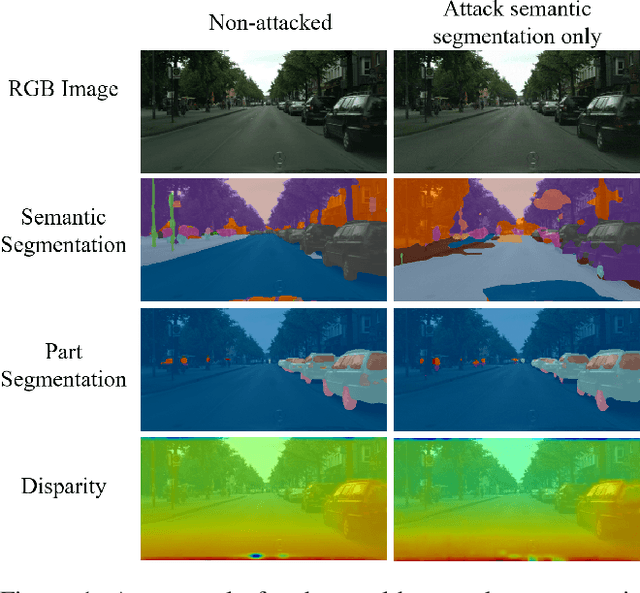
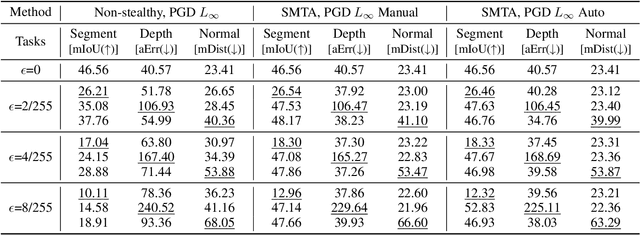
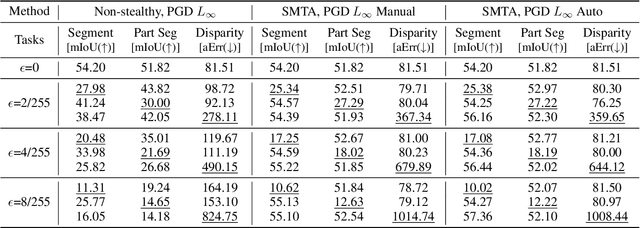

Abstract:Deep Neural Networks exhibit inherent vulnerabilities to adversarial attacks, which can significantly compromise their outputs and reliability. While existing research primarily focuses on attacking single-task scenarios or indiscriminately targeting all tasks in multi-task environments, we investigate selectively targeting one task while preserving performance in others within a multi-task framework. This approach is motivated by varying security priorities among tasks in real-world applications, such as autonomous driving, where misinterpreting critical objects (e.g., signs, traffic lights) poses a greater security risk than minor depth miscalculations. Consequently, attackers may hope to target security-sensitive tasks while avoiding non-critical tasks from being compromised, thus evading being detected before compromising crucial functions. In this paper, we propose a method for the stealthy multi-task attack framework that utilizes multiple algorithms to inject imperceptible noise into the input. This novel method demonstrates remarkable efficacy in compromising the target task while simultaneously maintaining or even enhancing performance across non-targeted tasks - a criterion hitherto unexplored in the field. Additionally, we introduce an automated approach for searching the weighting factors in the loss function, further enhancing attack efficiency. Experimental results validate our framework's ability to successfully attack the target task while preserving the performance of non-targeted tasks. The automated loss function weight searching method demonstrates comparable efficacy to manual tuning, establishing a state-of-the-art multi-task attack framework.
CoMamba: Real-time Cooperative Perception Unlocked with State Space Models
Sep 16, 2024



Abstract:Cooperative perception systems play a vital role in enhancing the safety and efficiency of vehicular autonomy. Although recent studies have highlighted the efficacy of vehicle-to-everything (V2X) communication techniques in autonomous driving, a significant challenge persists: how to efficiently integrate multiple high-bandwidth features across an expanding network of connected agents such as vehicles and infrastructure. In this paper, we introduce CoMamba, a novel cooperative 3D detection framework designed to leverage state-space models for real-time onboard vehicle perception. Compared to prior state-of-the-art transformer-based models, CoMamba enjoys being a more scalable 3D model using bidirectional state space models, bypassing the quadratic complexity pain-point of attention mechanisms. Through extensive experimentation on V2X/V2V datasets, CoMamba achieves superior performance compared to existing methods while maintaining real-time processing capabilities. The proposed framework not only enhances object detection accuracy but also significantly reduces processing time, making it a promising solution for next-generation cooperative perception systems in intelligent transportation networks.
Light the Night: A Multi-Condition Diffusion Framework for Unpaired Low-Light Enhancement in Autonomous Driving
Apr 07, 2024Abstract:Vision-centric perception systems for autonomous driving have gained considerable attention recently due to their cost-effectiveness and scalability, especially compared to LiDAR-based systems. However, these systems often struggle in low-light conditions, potentially compromising their performance and safety. To address this, our paper introduces LightDiff, a domain-tailored framework designed to enhance the low-light image quality for autonomous driving applications. Specifically, we employ a multi-condition controlled diffusion model. LightDiff works without any human-collected paired data, leveraging a dynamic data degradation process instead. It incorporates a novel multi-condition adapter that adaptively controls the input weights from different modalities, including depth maps, RGB images, and text captions, to effectively illuminate dark scenes while maintaining context consistency. Furthermore, to align the enhanced images with the detection model's knowledge, LightDiff employs perception-specific scores as rewards to guide the diffusion training process through reinforcement learning. Extensive experiments on the nuScenes datasets demonstrate that LightDiff can significantly improve the performance of several state-of-the-art 3D detectors in night-time conditions while achieving high visual quality scores, highlighting its potential to safeguard autonomous driving.
V2X-DGW: Domain Generalization for Multi-agent Perception under Adverse Weather Conditions
Mar 29, 2024



Abstract:Current LiDAR-based Vehicle-to-Everything (V2X) multi-agent perception systems have shown the significant success on 3D object detection. While these models perform well in the trained clean weather, they struggle in unseen adverse weather conditions with the real-world domain gap. In this paper, we propose a domain generalization approach, named V2X-DGW, for LiDAR-based 3D object detection on multi-agent perception system under adverse weather conditions. Not only in the clean weather does our research aim to ensure favorable multi-agent performance, but also in the unseen adverse weather conditions by learning only on the clean weather data. To advance research in this area, we have simulated the impact of three prevalent adverse weather conditions on two widely-used multi-agent datasets, resulting in the creation of two novel benchmark datasets: OPV2V-w and V2XSet-w. To this end, we first introduce the Adaptive Weather Augmentation (AWA) to mimic the unseen adverse weather conditions, and then propose two alignments for generalizable representation learning: Trust-region Weather-invariant Alignment (TWA) and Agent-aware Contrastive Alignment (ACA). Extensive experimental results demonstrate that our V2X-DGW achieved improvements in the unseen adverse weather conditions.
EVD4UAV: An Altitude-Sensitive Benchmark to Evade Vehicle Detection in UAV
Mar 08, 2024



Abstract:Vehicle detection in Unmanned Aerial Vehicle (UAV) captured images has wide applications in aerial photography and remote sensing. There are many public benchmark datasets proposed for the vehicle detection and tracking in UAV images. Recent studies show that adding an adversarial patch on objects can fool the well-trained deep neural networks based object detectors, posing security concerns to the downstream tasks. However, the current public UAV datasets might ignore the diverse altitudes, vehicle attributes, fine-grained instance-level annotation in mostly side view with blurred vehicle roof, so none of them is good to study the adversarial patch based vehicle detection attack problem. In this paper, we propose a new dataset named EVD4UAV as an altitude-sensitive benchmark to evade vehicle detection in UAV with 6,284 images and 90,886 fine-grained annotated vehicles. The EVD4UAV dataset has diverse altitudes (50m, 70m, 90m), vehicle attributes (color, type), fine-grained annotation (horizontal and rotated bounding boxes, instance-level mask) in top view with clear vehicle roof. One white-box and two black-box patch based attack methods are implemented to attack three classic deep neural networks based object detectors on EVD4UAV. The experimental results show that these representative attack methods could not achieve the robust altitude-insensitive attack performance.
Abductive Ego-View Accident Video Understanding for Safe Driving Perception
Mar 01, 2024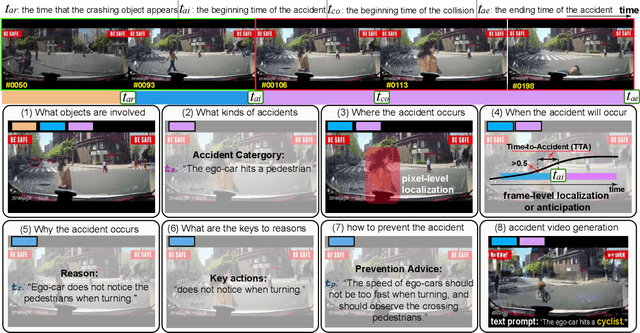
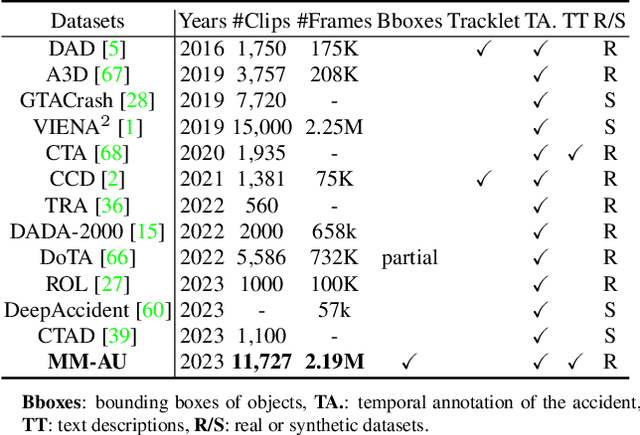
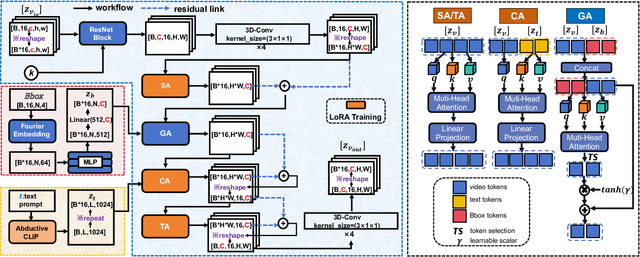
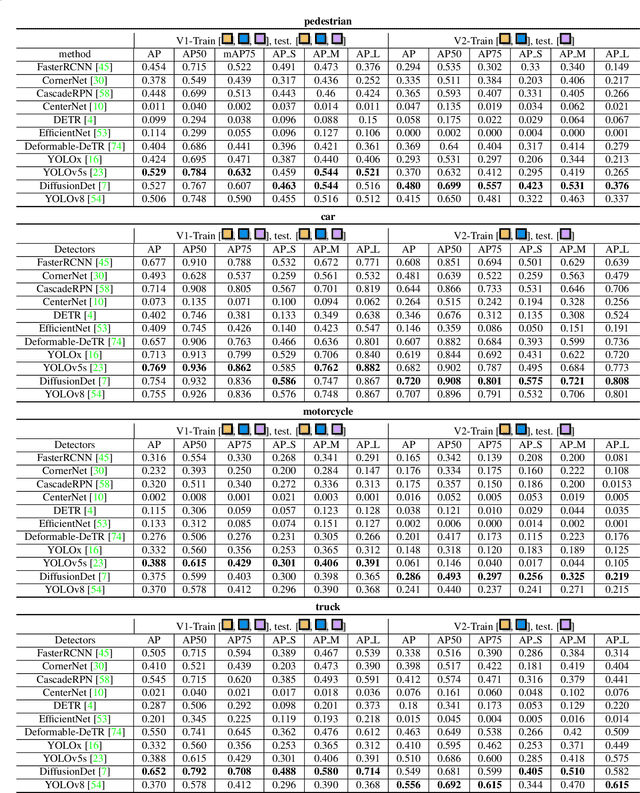
Abstract:We present MM-AU, a novel dataset for Multi-Modal Accident video Understanding. MM-AU contains 11,727 in-the-wild ego-view accident videos, each with temporally aligned text descriptions. We annotate over 2.23 million object boxes and 58,650 pairs of video-based accident reasons, covering 58 accident categories. MM-AU supports various accident understanding tasks, particularly multimodal video diffusion to understand accident cause-effect chains for safe driving. With MM-AU, we present an Abductive accident Video understanding framework for Safe Driving perception (AdVersa-SD). AdVersa-SD performs video diffusion via an Object-Centric Video Diffusion (OAVD) method which is driven by an abductive CLIP model. This model involves a contrastive interaction loss to learn the pair co-occurrence of normal, near-accident, accident frames with the corresponding text descriptions, such as accident reasons, prevention advice, and accident categories. OAVD enforces the causal region learning while fixing the content of the original frame background in video generation, to find the dominant cause-effect chain for certain accidents. Extensive experiments verify the abductive ability of AdVersa-SD and the superiority of OAVD against the state-of-the-art diffusion models. Additionally, we provide careful benchmark evaluations for object detection and accident reason answering since AdVersa-SD relies on precise object and accident reason information.
Breaking Data Silos: Cross-Domain Learning for Multi-Agent Perception from Independent Private Sources
Feb 20, 2024



Abstract:The diverse agents in multi-agent perception systems may be from different companies. Each company might use the identical classic neural network architecture based encoder for feature extraction. However, the data source to train the various agents is independent and private in each company, leading to the Distribution Gap of different private data for training distinct agents in multi-agent perception system. The data silos by the above Distribution Gap could result in a significant performance decline in multi-agent perception. In this paper, we thoroughly examine the impact of the distribution gap on existing multi-agent perception systems. To break the data silos, we introduce the Feature Distribution-aware Aggregation (FDA) framework for cross-domain learning to mitigate the above Distribution Gap in multi-agent perception. FDA comprises two key components: Learnable Feature Compensation Module and Distribution-aware Statistical Consistency Module, both aimed at enhancing intermediate features to minimize the distribution gap among multi-agent features. Intensive experiments on the public OPV2V and V2XSet datasets underscore FDA's effectiveness in point cloud-based 3D object detection, presenting it as an invaluable augmentation to existing multi-agent perception systems.
 Add to Chrome
Add to Chrome Add to Firefox
Add to Firefox Add to Edge
Add to Edge